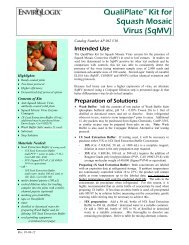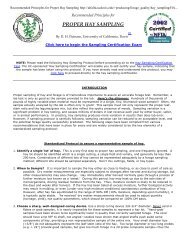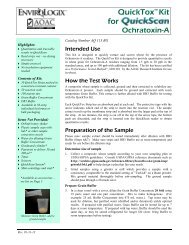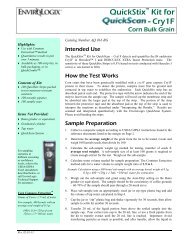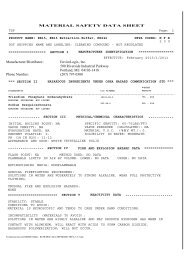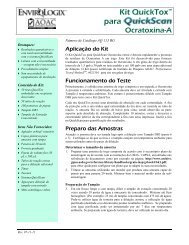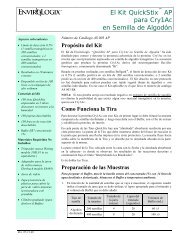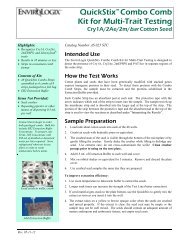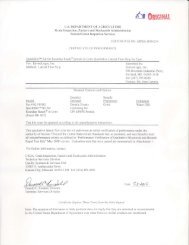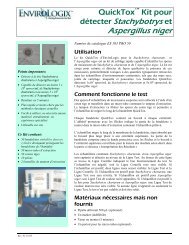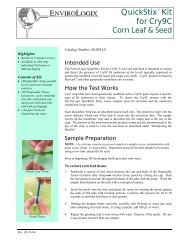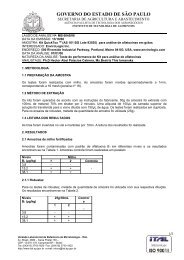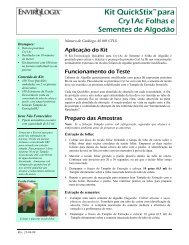Insert - EnviroLogix
Insert - EnviroLogix
Insert - EnviroLogix
You also want an ePaper? Increase the reach of your titles
YUMPU automatically turns print PDFs into web optimized ePapers that Google loves.
Highlights:<br />
Use a single test well to<br />
screen corn seeds or leaf<br />
samples for presence/<br />
absence of Cry1Ab and<br />
Cry3Bb1<br />
Results for two analytes in<br />
three hours<br />
Contents of Kit:<br />
Cry1Ab and Cry3Bb1<br />
antibody-coated solid plate<br />
Enzyme Conjugate<br />
Positive Control ground<br />
corn<br />
S1 Substrate (for Cry3Bb1<br />
results)<br />
S2 Substrate (for Cry1Ab<br />
results)<br />
Note: To handle bulk<br />
packaged Enzyme<br />
Conjugate, S1 Substrate and<br />
S2 Substrate: into clean<br />
containers, pour off 6 mL of<br />
Conjugate and 11 mL of<br />
each Substrate per plate to<br />
be run each day. Use a<br />
multiple-channel pipette to<br />
dispense. Do not pour<br />
excess Substrates back into<br />
the reagent bottles.<br />
Rev. 07-12-12<br />
QualiPlate Combo Kit<br />
for Cry1Ab & Cry3Bb1<br />
Corn<br />
Catalog Number AP 039<br />
Intended Use<br />
The <strong>EnviroLogix</strong> QualiPlate Combo Kit for Cry1Ab & Cry3Bb1 is designed for the<br />
qualitative laboratory detection of the presence or absence of Cry1Ab and Cry3Bb1<br />
protein in corn single leaf or single seed samples, with both analytes measured in the<br />
same well of the assay plate. This assay can be used to detect the presence of these<br />
proteins in corn products including Yieldgard®, Yieldgard Rootworm, Yieldgard Plus,<br />
YieldGard VT Rootworm/RR2 , and YieldGard VT Triple as follows:<br />
YieldGard Rootworm<br />
YieldGard Plus<br />
YieldGard Plus/RR2<br />
YieldGard VT Triple<br />
YieldGard VT Rootworm/RR2<br />
Cry3Bb1 • • • •<br />
Cry1Ab • • •<br />
How the Test Works<br />
YieldGard<br />
YieldGard/RR2<br />
This QualiPlate Kit is a “sandwich” Enzyme-Linked ImmunoSorbent Assay (ELISA).<br />
In the test, corn sample extracts are added to test wells coated with antibodies that<br />
recognize Cry1Ab and Cry3Bb1 proteins. Any Cry1Ab or Cry3Bb1 protein present in<br />
the sample extract binds to the antibodies and is then detected by addition of alkalinephosphatase-labeled<br />
Cry3Bb1 antibody, or horseradish peroxidase-labeled Cry1Ab<br />
antibody.<br />
After a simple wash step, the results of the Cry3Bb1 assay are determined via the<br />
addition of a p-nitrophenyl phosphate S1 Substrate. Once the yellow color develops<br />
and is read, the wash step is repeated, and a 3,3’,5,5’-tetramethylbenzidine S2<br />
Substrate is added. The Cry1Ab results are determined via the development of the<br />
resulting blue color.<br />
Light color = Low concentration<br />
Darker color = High concentration<br />
Non-Specific Interferences<br />
The performance of this QualiPlate Kit when testing single leaf or seed samples will<br />
not be adversely affected by the presence of leaf or seed from the following nontransgenic<br />
crops:<br />
Barley, canola, cotton, rice, sorghum, soybean, sugar beet, or wheat.<br />
Note that any Cry1Ac-containing cotton will cause a positive result in the Cry1Ab<br />
portion of this test kit.
Materials Not Provided<br />
PBS/0.05% Tween-20, pH<br />
7.4 Wash Buffer (may be<br />
purchased in 1L dry<br />
packets from Sigma<br />
Chemicals, Cat#P-3563, or<br />
prepared from salts on<br />
site). Store at controlled<br />
ambient temperature for up<br />
to one week, then discard.<br />
PBS/0.55% Tween-20<br />
Extraction Buffer May be<br />
prepared by adding 0.5%<br />
(5 mL per liter) Tween-20<br />
to already prepared PBS/<br />
0.05% Tween-20 Wash<br />
Buffer. Prepare only<br />
enough for a few days’<br />
usage. Store refrigerated<br />
when not in use; warm to<br />
room temperature prior to<br />
assay.<br />
distilled or deionized water<br />
for preparing above<br />
solutions<br />
<strong>EnviroLogix</strong> Tissue<br />
Extraction Kit (ACC 002)<br />
or other suitable equipment<br />
for taking and extracting<br />
leaf punch samples<br />
equipment for pulverizing<br />
seeds or leaves<br />
user-supplied controls:<br />
seed and/or leaf extracts<br />
from known negative(highly<br />
recommended) and positive<br />
samples (optional)<br />
disposable tip, adjustable<br />
air-displacement multichannel<br />
pipettes which will<br />
measure 50 and 100<br />
microliters (µL)<br />
marking pen (indelible)<br />
tape or Parafilm®<br />
timer<br />
microtiter plate reader with<br />
405 and 650 or 630 nm<br />
filters<br />
wash bottle, or microtiter<br />
plate washer<br />
Rev. 07-12-12<br />
QualiPlate Combo Kit for Cry1Ab & Cry3Bb1 Corn<br />
Page 2 of 6<br />
Sample Preparation<br />
Note: It is recommended that the user prepare known negative and positive seed or<br />
leaf samples to be run in every assay as controls, in addition to the Positive Control<br />
ground corn supplied with the kit.<br />
Positive Control Ground Corn extract:<br />
Extracts of this control must be run in every assay. To extract, add 5 mL of Extraction<br />
Buffer to the tube containing 2 grams of ground Control corn. Cap and shake<br />
vigorously by hand or vortex for 20-30 seconds. Let stand at room temperature for 1<br />
hour to extract. Mix again at the end of the hour, then clarify by allowing to settle 10<br />
minutes or by centrifuging 5 minutes at 5000 x g.<br />
If running the assay at a later date, or more than one assay per plate, freeze (-20°C) 0.5<br />
mL aliquots of each clarified extract in a non-self-defrosting freezer for up to 6<br />
months. Thaw just prior to use.<br />
Single Seed Samples<br />
1. Crush seeds: Seeds may be placed in a re-sealable plastic bag and smashed with a<br />
rubber mallet or hammer, then transferred to a tube for extraction; alternately, a<br />
drill-press based machine incorporating a seed cutter/48-well plate combination<br />
may be used (for example Hypure #HCT-100, PerkinElmer, Norton, OH, with<br />
Costar plate #3548, Corning Life Sciences, Acton, MA, or equivalent). If using<br />
this cutting equipment, it is recommended that you cut the seeds 4 times, rotating<br />
the seeds between cuttings. If necessary, a metal probe should be used to manually<br />
rotate lodged seeds for thorough cutting. Make certain that each seed has been<br />
broken into at least 3 pieces.<br />
NOTE: Cry3Bb1 protein is expressed at high concentrations in corn seed compared to<br />
Cry1Ab. There is serious potential for cross-contamination with Cry3Bb1 between<br />
samples during seed crushing. Use the utmost care to avoid this.<br />
2. Add 0.75 mL of Extraction Buffer to each crushed corn seed. Mix for at least 30<br />
seconds, let stand 1 - 24 hours (overnight extraction should be done at refrigerator<br />
temperatures), then mix again. For optimal extraction, shake for the last few<br />
minutes on an orbital shaker or other mixer (taking care not to splash extract out of<br />
the tubes or wells). Visually examine extracted seed samples for the absence of<br />
intact seeds. Well-extracted seeds should result in a white to yellow cloudy extract.<br />
Note the presence of any extracts that appear clear and/or colorless – these may not<br />
have extracted properly and assay data would be invalid. For best results, extract<br />
another sample from the seed lot.<br />
Single Leaf Punch Samples:<br />
1. Take two leaf punches of approximately 5 millimeters diameter or a single punch<br />
of 10 mm diameter, using a paper punch or a micro-tube cap. Mash the leaf tissue<br />
with a pestle matched to the micro-tube, or beat with beads in a reciprocating<br />
shaker to the point of liquefaction of the leaf. The extraction efficiency of<br />
whatever method used will vary proportionately with the amount of tissue<br />
disruption performed.<br />
2. Add 0.5 mL of Extraction Buffer per sample and macerate again. Assay<br />
immediately, or after overnight extraction at refrigerator temperature. For optimal<br />
extraction, shake for the last few minutes on an orbital shaker or other mixer<br />
(taking care not to splash extract out of the tubes or wells). Use extreme care not<br />
to cross-contaminate between leaf samples. Visually examine extracted leaf<br />
samples for the absence of intact leaf punches. Well-extracted leaves should result<br />
in a green cloudy extract. Note the presence of any extracts that appear clear<br />
and/or colorless – these may not have extracted properly and assay data would be<br />
invalid. For best results, extract another representative sample.
Prepare Wash and<br />
Extraction buffer<br />
Add Enzyme-Conjugate,<br />
followed immediately by<br />
Control and sample extracts,<br />
to the plate<br />
Rev. 07-12-12<br />
Mix<br />
QualiPlate Combo Kit for Cry1Ab & Cry3Bb1 Corn<br />
Page 3 of 6<br />
How to Run the Assay<br />
Read all of these instructions before running the kit.<br />
Allow all reagents to reach room temperature before beginning (at least 30 minutes<br />
with un-boxed plates and reagents at room temperature - do not remove plate from<br />
bag with desiccant until it has warmed up).<br />
Organize all Control and sample extracts and pipettes so that Step 1 can be<br />
performed in 15 minutes or less, using a multi-channel pipette.<br />
Use the well identification markings on the plate frame to guide you when adding<br />
the samples and reagents. For this qualitative assay, duplicate wells of the<br />
Extraction Buffer blank (BL), user-supplied known-negative control (NC) and kitsupplied<br />
Positive Control (PC) ground corn extracts, along with 90 sample extracts<br />
(S) (including any other user-supplied controls) in single wells may be run on one<br />
plate. (See the Qualitative Assay Example Plate Layout - Figure 1A).<br />
1. Add 50 µL of Cry1Ab/Cry3Bb1 Enzyme Conjugate to each well, followed<br />
immediately by 50 µL of Extraction Buffer Blank (BL), 50 µL each of<br />
Negative and Positive Control extracts, and 50 µL of each sample/userprepared<br />
control extract (S) to their respective wells, as shown in Figure 1A.<br />
Caution: Dispensing particles into the test plate can cause false positive results.<br />
NOTE: In order to minimize setup time it is strongly recommended that a multichannel<br />
pipette be used in steps 1, 5, and 10.<br />
2. Thoroughly mix the contents of the wells by moving the plate in a rapid circular<br />
motion on the bench top for a full 20-30 seconds. Be careful not to spill contents!<br />
3. Cover the wells with tape or Parafilm to prevent evaporation and incubate at<br />
ambient temperature for 2 hours.<br />
4. After incubation, carefully remove the covering and vigorously shake the<br />
contents of the wells into a sink or other suitable container. Flood the wells<br />
completely with Wash Buffer, then shake to empty. Repeat this wash step three<br />
times. Alternatively, perform these four washes (300 µL/well) with a microtiter<br />
plate or strip washer. Slap the inverted plate on a paper towel to remove as much<br />
liquid as possible.<br />
5. Add 100 µL of S1 Substrate to each well. BE SURE TO USE S1 SUBSTRATE<br />
AT THIS STEP!<br />
6. Thoroughly mix the contents of the wells as described in step 2. Be careful not<br />
to spill the contents!<br />
7. Cover the wells with new tape or Parafilm to prevent evaporation and incubate<br />
at ambient temperature for 20 to 30 minutes.<br />
8. Read and record the yellow Cry3Bb1 results using a microtiter plate reader<br />
at a wavelength of 405 nanometers. Set the plate reader to blank on the<br />
Extraction Buffer Blank wells (this should automatically subtract the mean<br />
optical density (OD) of the Blank wells from each control and sample OD).<br />
9. Wash the plate four times as described in step 4.<br />
10. Add 100 µL of S2 Substrate to each well. BE SURE TO USE S2 SUBSTRATE<br />
AT THIS STEP!<br />
11. Thoroughly mix the contents of the wells as described in step 2. Be careful not<br />
to spill the contents!<br />
12. Cover the wells with new tape or Parafilm to prevent evaporation and incubate<br />
at ambient temperature for 20 to 30 minutes.
Rev. 07-12-12<br />
Wash Plate<br />
Read plates in a Plate Reader<br />
at the appropriate wavelength:<br />
405 nanometers for the<br />
Cry3Bb1 test result,<br />
650 OR 630 nanometers for<br />
the Cry1Ab test results.<br />
QualiPlate Combo Kit for Cry1Ab & Cry3Bb1 Corn<br />
Page 4 of 6<br />
13. Read and record the blue Cry1Ab results with a microtiter plate reader at a<br />
wavelength of 650 or 630 nanometers. Set the plate reader to blank on the<br />
Extraction Buffer Blank wells (this should automatically subtract the mean OD<br />
of the Blank wells from each control and sample OD).<br />
How to Interpret the Results<br />
Spectrophotometric Measurement<br />
General test criteria:<br />
The mean OD of the BLANK wells in the Cry1Ab portion of the test should not<br />
exceed 0.15. The mean OD of the BLANK wells in the Cry3Bb1 portion of the test<br />
should not exceed 0.35.<br />
The mean, blank-subtracted OD of the Positive Control Solution wells should be at<br />
least 0.2.<br />
The coefficient of variance (CV) between the duplicate Positive Control Solution<br />
wells should not exceed 15%:<br />
%CV = standard deviation of OD’s x 100<br />
mean Positive Control OD<br />
If the results of an assay fail to meet these criteria, consult <strong>EnviroLogix</strong> Technical<br />
Service for suggestions on improving the test when you repeat the assay.<br />
Calculate the Positive Control Ratio<br />
Divide the OD of each sample extract by the mean OD of the Positive Control Ground<br />
Corn extract wells. This number is the “Positive Control Ratio”.<br />
Interpret the Qualitative Results<br />
Cry3Bb1 & Cry1Ab Results:<br />
If the Positive Control Ratio calculated for a single seed or leaf punch sample in either<br />
the Cry3Bb1 or Cry1Ab portion of the test is less than 0.5, the sample does not contain<br />
that protein .<br />
If the Positive Control Ratio of a sample in either the Cry3Bb1 or Cry1Ab portion of<br />
the test is greater than or equal to 0.5, the sample contains that protein.<br />
Single leaf and seed samples are by their nature either 100% positive or 100%<br />
negative, resulting in a clear delineation of color between negative and positive<br />
samples. Low level positive results may be due to insufficient extraction, or can be<br />
caused by some form of sample cross-contamination (flying particles or dust from corn<br />
seed, corn leaf residue on leaf punch, etc.) or by transfer of particulate matter from leaf<br />
or seed extracts into the assay wells. Re-extraction and re-testing of questionable<br />
samples is recommended.<br />
Contact <strong>EnviroLogix</strong> Technical Service for assistance with making this test work best<br />
with your own samples and extraction equipment/protocols. When positive samples are<br />
not as well delineated from negative samples as they should be, any or all of the<br />
following alterations to the testing may help: Change the extraction method to one that<br />
causes more disruption to the sample; increase the extraction time and the degree of<br />
mixing during extraction; increase the Enzyme-Conjugate/sample reaction step time;<br />
add time onto either or both of the substrate development steps (in 10 minute<br />
increments).<br />
This Kit recognizes the following enhanced crops containing both the biotechnology<br />
proteins Cry1Ab and Cry3Bb1: YieldGard Plus, YieldGard VT Rootworm/RR2, and<br />
YieldGard VT Triple.
Rev. 07-12-12<br />
QualiPlate Combo Kit for Cry1Ab & Cry3Bb1 Corn<br />
Page 5 of 6<br />
Corn products such as YieldGard, Agrisure CB LL, and Agrisure GT CB LL will<br />
run positive in the Cry1Ab portion of the assay, while YieldGard Rootworm will run<br />
positive in the Cry3Bb1 portion of the assay. See table on page 1.<br />
Figure 1A. Example of a typical qualitative assay setup.<br />
1 2 3 4 5 6 7 8 9 10 11 12<br />
A BL S6 S14 S22 S30 S38 S46 S54 S62 S70 S78 S86<br />
B NC S7 S15 S23 S31 S39 S47 S55 S63 S71 S79 S87<br />
C PC S8 S16 S24 S32 S40 S48 S56 S64 S72 S80 S88<br />
D S1 S9 S17 S25 S33 S41 S49 S57 S65 S73 S81 S89<br />
E S2 S10 S18 S26 S34 S42 S50 S58 S66 S74 S82 S90<br />
F S3 S11 S19 S27 S35 S43 S51 S59 S67 S75 S83 BL<br />
G S4 S12 S20 S28 S36 S44 S52 S60 S68 S76 S84 NC<br />
H S5 S13 S21 S29 S37 S45 S53 S61 S69 S77 S85 PC<br />
Precautions and Notes<br />
Store all kit components at 4°C to 8°C (39°F to 46°F) when not in use.<br />
Do not expose kit components to temperatures greater than 37°C (99°F) or less than<br />
2°C (36°F).<br />
Allow all reagents to reach ambient temperature (18°C to 27°C or 64°F to 81°F)<br />
before use.<br />
Do not use kit components after the expiration date.<br />
Do not use reagents or plates from one QualiPlate Kit with reagents or plates from a<br />
different QualiPlate Kit.<br />
Do not expose S1 Substrate or S2 Substrate to sunlight during pipetting or while<br />
incubating in the test wells.<br />
Do not dilute or adulterate test reagents or use samples not called for in the test<br />
procedure.<br />
Do not use a stopping solution of any kind during this assay.<br />
As with all tests, it is recommended that results be confirmed by an alternate method<br />
when necessary.<br />
Observe any applicable regulations when disposing of samples and kit reagents.<br />
This kit will detect Cry3Bb1 protein found in multiple corn hybrids including<br />
YieldGard Rootworm, YieldGard Plus, YieldGard VT Rootworm/RR2, and<br />
YieldGard VT Triple. The test does not necessarily distinguish between these corn<br />
hybrids.
For Technical Support<br />
Contact Us At:<br />
<strong>EnviroLogix</strong><br />
500 Riverside Industrial<br />
Parkway<br />
Portland, ME 04103-1486<br />
USA<br />
Tel: (207) 797-0300<br />
Toll Free: 866-408-4597<br />
Fax: (207) 797-7533<br />
e-mail:<br />
info@envirologix.com<br />
Website:<br />
www.envirologix.com<br />
Rev. 07-12-12<br />
QualiPlate Combo Kit for Cry1Ab & Cry3Bb1 Corn<br />
Page 6 of 6<br />
LIMITED WARRANTY<br />
<strong>EnviroLogix</strong> Inc. (“<strong>EnviroLogix</strong>”) warrants the products sold hereunder (“the<br />
Products”) against defects in materials and workmanship when used in accordance<br />
with the applicable instructions for a period not to extend beyond a product’s printed<br />
expiration date. If the Products do not conform to this Limited Warranty and the<br />
customer notifies <strong>EnviroLogix</strong> in writing of such defects during the warranty period,<br />
including an offer by the customer to return the Products to <strong>EnviroLogix</strong> for<br />
evaluation, <strong>EnviroLogix</strong> will repair or replace, at its option, any product or part thereof<br />
that proves defective in materials or workmanship within the warranty period.<br />
NEITHER ENVIROLOGIX NOR MONSANTO MAKES ANY OTHER<br />
WARRANTIES, EXPRESS OR IMPLIED, INCLUDING BUT NOT LIMITED TO<br />
ANY IMPLIED WARRANTIES OF MERCHANTABILITY OR FITNESS FOR A<br />
PARTICULAR PURPOSE. The warranty provided herein and the data, specifications<br />
and descriptions of <strong>EnviroLogix</strong> products appearing in <strong>EnviroLogix</strong> published<br />
catalogues and product literature are <strong>EnviroLogix</strong>’ sole representations concerning the<br />
Products and warranty. No other statements or representations, written or oral, by<br />
<strong>EnviroLogix</strong>’ employees, agents or representatives, except written statements signed<br />
by a duly authorized officer of <strong>EnviroLogix</strong> Inc., are authorized; they should not be<br />
relied upon by the customer and are not a part of the contract of sale or of this<br />
warranty.<br />
<strong>EnviroLogix</strong> does not warrant against damages or defects arising in shipping or<br />
handling, or out of accident or improper or abnormal use of the Products; against<br />
defects in products or components not manufactured by <strong>EnviroLogix</strong>, or against<br />
damages resulting from such non-<strong>EnviroLogix</strong> made products or components.<br />
<strong>EnviroLogix</strong> passes on to customer the warranty it received (if any) from the maker<br />
thereof of such non-<strong>EnviroLogix</strong> made products or components. This warranty also<br />
does not apply to Products to which changes or modifications have been made or<br />
attempted by persons other than pursuant to written authorization by <strong>EnviroLogix</strong>.<br />
THIS WARRANTY IS EXCLUSIVE. The sole and exclusive obligation of<br />
<strong>EnviroLogix</strong> shall be to repair or replace the defective Products in the manner and for<br />
the period provided above. <strong>EnviroLogix</strong> shall not have any other obligation with<br />
respect to the Products or any part thereof, whether based on contract, tort, strict<br />
liability or otherwise. Under no circumstances, whether based on this Limited<br />
Warranty or otherwise, shall <strong>EnviroLogix</strong> be liable for incidental, special, or<br />
consequential damages.<br />
This Limited Warranty states the entire obligation of <strong>EnviroLogix</strong> with respect to the<br />
Products. If any part of this Limited Warranty is determined to be void or illegal, the<br />
remainder shall remain in full force and effect.<br />
LICENSE<br />
<strong>EnviroLogix</strong> has developed this kit using proprietary reagents as well as reagents<br />
licensed from the Monsanto Company.<br />
YieldGard ® , YieldGard VT Rootworm/RR2 , and YieldGard VT Triple are trademarks of<br />
Monsanto Technology LLC<br />
Parafilm is a registered trademark of American Can Corporation<br />
Agrisure is a trademark of Syngenta Group Company<br />
<strong>EnviroLogix</strong>, the <strong>EnviroLogix</strong> logo, and QualiPlate are trademarks of <strong>EnviroLogix</strong> Inc.<br />
© <strong>EnviroLogix</strong> 2007



